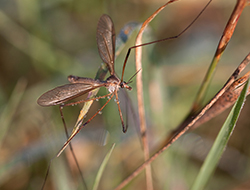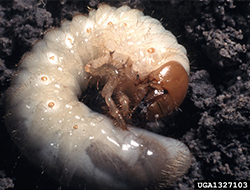No matter where you live, you battle pests that munch, chew and feast on your turf. Pests vary by region, and what plagues lawns in Philadelphia may not cause trouble in Flagstaff. Learn about different lawn pests and discover which ones threaten your region. Review feeding symptoms so you’ll know when you have a problem.

European Crane Flies
- What they look like: Adults resemble large mosquitoes and appear in late summer and fall. They do not bite or sting. Larvae, called leatherjackets, are small, brown and wormlike.
- Damage: Leatherjacket larvae feed on grass roots in spring and summer, creating brown patches. Heaviest feeding occurs as leatherjackets mature in summer.
- Diagnose: Cut a three-sided 6- to 12-inch-square of sod. Dig down 4 inches. Peel the sod back and look for leatherjackets. In a healthy lawn, 25 leatherjackets per square foot of lawn will cause damage. Also watch for birds patrolling your lawn, digging for the larvae.
- Affected areas: Heavy infestations plague the Pacific Northwest and New York. Scattered invasions are reported in Ohio, Wisconsin and throughout New England.

Southern Chinch Bugs
- What they look like: Immature chinch bugs are reddish-orange with a white band across the back. They darken in color, turning black once they become adults. Adults have shiny white wings that fold neatly over the body. They grow to 1/8 to 1/5 inch long.
- Damage: Grass in sunny sections of the lawn wilts, turns brown and dies. Once wilting begins, adjacent areas become affected rapidly, often in a day or so. Infestations can be spotty and sometimes are found only in portions of the lawn. Left untreated, these patches will grow and the entire lawn can be lost. Damage typically occurs from spring to fall. Insects hide in the thatch layer or individual grass crowns.
- Diagnose: Try this method if you do not see chinch bugs but suspect they are causing damage. Remove both ends of a coffee container. Insert the bottom edge into soil about 3 inches. Fill the container with water for five minutes. If chinch bugs are present, they’ll float to the top of the water. Test near the edges of the damaged lawn section.
- Affected areas: Heaviest infestations occur in the South, including coastal and tropical areas. Scattered infestations occur throughout the Southwest, Mountain West and High Plains. Chinch bugs cause the most damage to St. Augustine grass but are a serious pest of centipede grass as well.

White Grubs
- What they look like: Grubs are soft-bodied creatures, creamy in color, with legs near the head. They’re usually C-shaped and vary from dime to quarter size. Lawn grubs are the immature form of scarab beetles, such as June bugs (beetles), European chafers and Japanese beetles.
- Damage: Brown patches appear in a lawn. Grass rolls up like a carpet because roots have been eaten. Turf may feel spongy. Damaged turf can be grasped and lifted up due to root damage.
- Diagnose: Cut a three-sided 12- by 12-inch-square of sod, digging down 2 to 4 inches. Peel the sod back and look for grubs. In a healthy lawn, 10 or more grubs per square foot of lawn will cause damage. Birds, skunks, raccoons and armadillos may dig up lawn to get to grubs.
- Affected areas: Various species of scarab beetle grubs attack lawns throughout all regions of the country.
Photos
Image 5489150: David Sheltar, The Ohio State University, Bugwood.org
Image 1327103: Alton N. Sparks, Jr., University of Georgia, Bugwood.org

